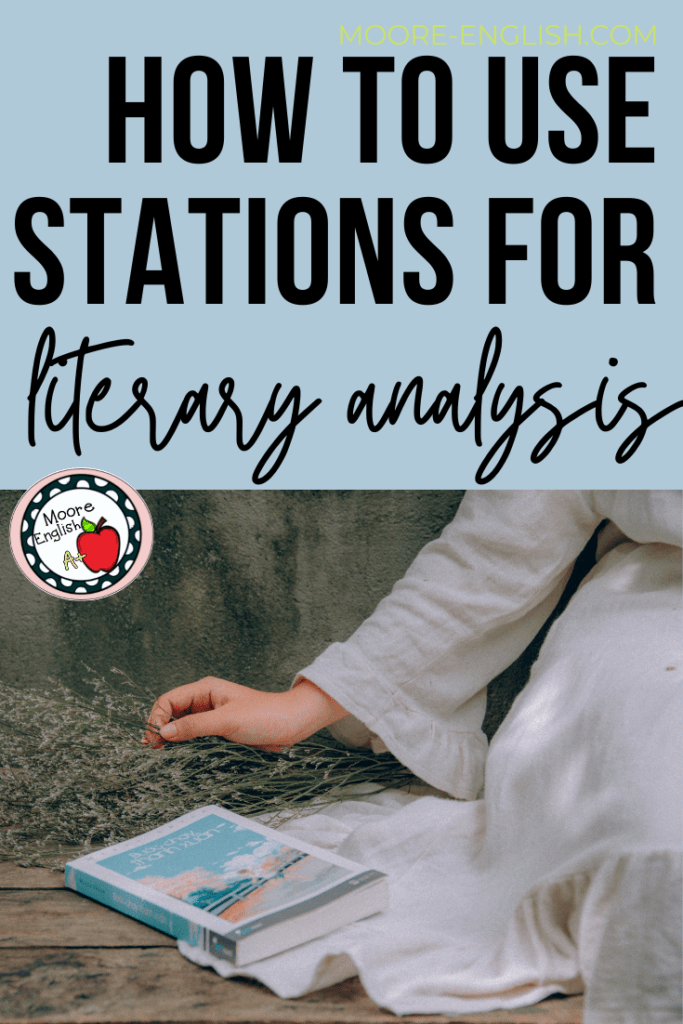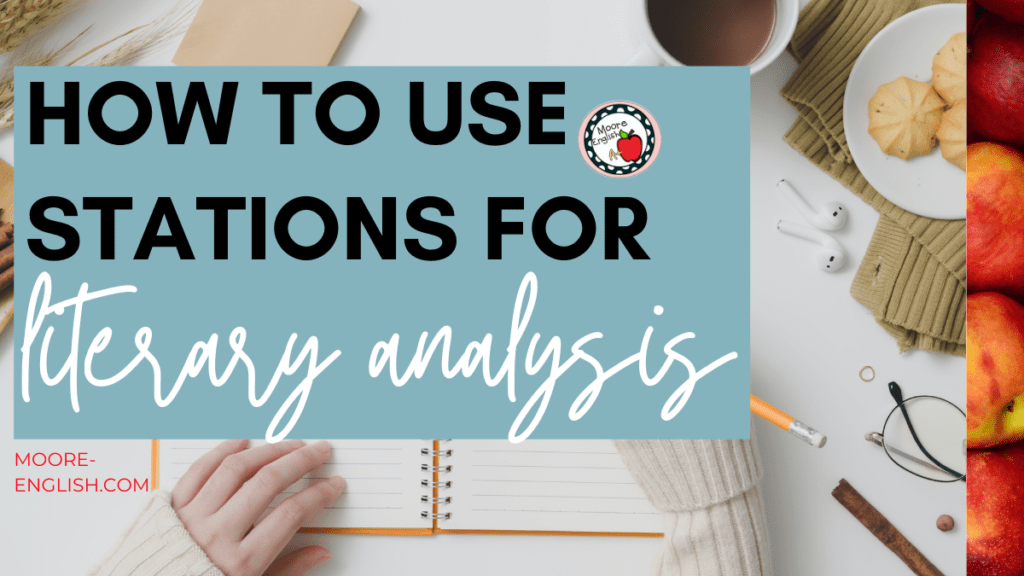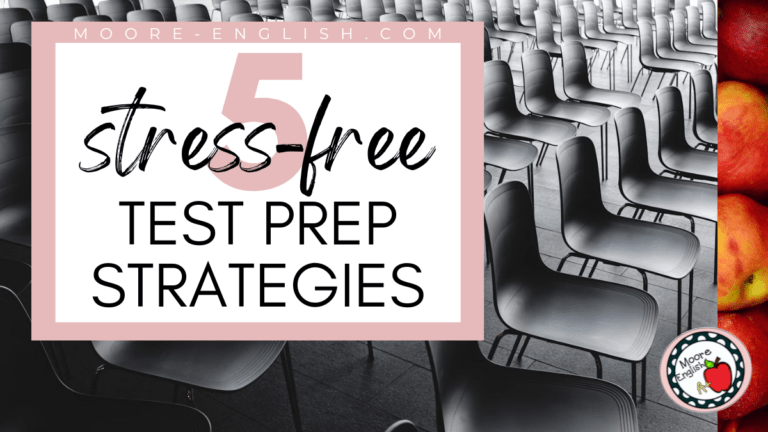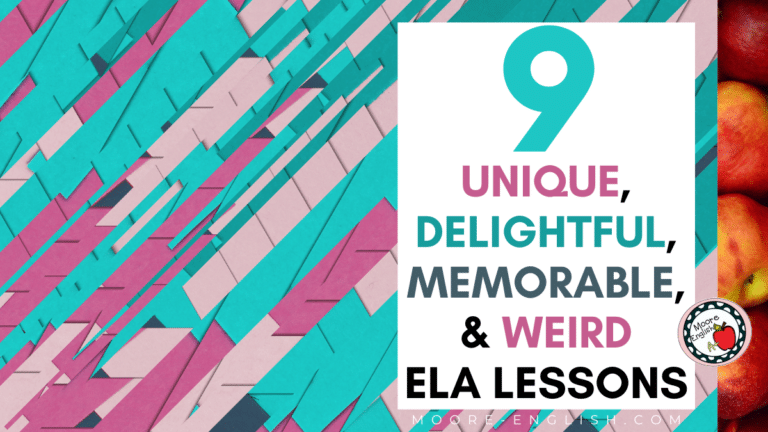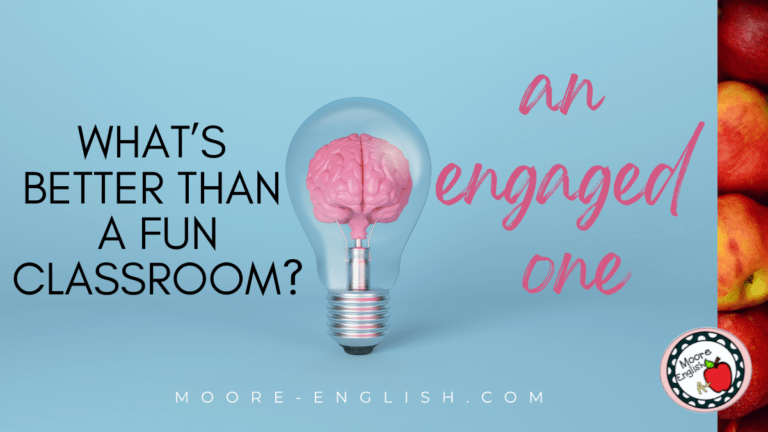The first summative writing assignment my students complete is a literary analysis essay. I like to begin the year with this assignment for a few reasons:
- Firstly, we can review figurative language, story elements, and theme.
- Secondly, students can practice structured writing. This gives me a good idea of what we will need to practice as we work into more complex writing.
- Finally, we can focus on critical thinking skills without the extra complication of research.
Prior to starting our essays, we review a variety of literary devices and story elements. Rather than use tedious lectures or notes, stations provide students with an opportunity to show off what they know without being bored to tears. Here are some stations students can visit to prepare for literary analysis.
This post this post may contain affiliate links. Please read the Terms of Use.
Starting with Summary
When I start putting stations groups together, I start my strugglers here. I start this group here because summary is a familiar skill. Furthermore, if students struggle with this skill, it often indicates a need to focus on reading comprehension. This gives me a plan moving forward.
Exactly what I put at this station differs based on the unit and time of year. Sometimes I put several options at this station, and students choose how they want to demonstrate their mastery.
- Twitter Summaries (Beginning Level): When I am pressed for time, Twitter summaries are my go-to option. Students enjoy this activity, especially when they start adding hashtags. Grab my template for this today!
- Paraphrasing and Summarizing Graphic Organizer (Intermediate Level): Especially before writing a literary analysis essay, it’s important for students to review the differences between using direct quotes, paraphrases, and summaries. I use this graphic organizer to help students practice all three skills. First, students choose an important quote (or, depending on time, I choose an important quote) that students practice citing. Then, students take the same quote and paraphrase it. Finally, students summarize the same quote and provide one more citation.
- About the Author (Proficient Level): This is a fun, creative option. Students design an About the Author page. This provides students with the opportunity to build a little prior knowledge and, in certain cases, historical context. This station can also provide a good opportunity for light research about the author.
- Book Cover Design (Advanced Level): The Book Cover Design project takes several days of stations, and it’s creative! This is a chance to practice multiple skills. Students can practice visualizing, summarizing, and researching!
Story Elements and Literary Analysis
Story elements are another important part of literary analysis. This is a station I always include. Regardless of what we’re reading (short stories, a whole-class novel, independent reading), all stories have these pieces. Furthermore, as students see these elements more often, they are able to move to higher levels of nuance and sophistication.
- Introductory Video (Beginning Level): I have to admit that I am a sucker for Flocabulary. Even though its target audience is probably not my students, they always seem to enjoy this video. After watching the video, I have students quickly jot down how the different literary elements appear in the text.
- Setting Postcards (Beginning Level): At the high school level, students have the tendency to ignore setting. However, setting is a key part of a story and includes more than location. To help students consider how setting affects mood, ask students to design a setting postcard. This gives students a chance to visualize, practice imagery, and do a quick write. They might address a favorite character or the author. To level up this station, consider having students write their postcards from a specific character’s point of view. Check out my favorite template for this option.
- Plot Diagram (Intermediate Level): A plot diagram might seem like an elementary idea. However, plot diagrams are a great way for students to visualize a text. As students encounter texts with complex plots, a plot diagram can be a familiar place to begin. Check out my favorite options for plot and conflict.
- Characterization (Proficient to Advanced Level): Depending on what we’re reading, characterization can be its own station. There are a huge variety of activities to place at Characterization Station. Check out some of my favorite tools for this station!
- Poetry Practice (Advanced Level): I also use stations to refine skills and as test prep. In this situation, I prefer to give students a cold read and let them work through it as a group. This collection of poems does a great job helping students practice analyzing story elements.
Theme and Author’s Purpose
Theme is so important that I always create a theme-focused station. At this station, students complete activities that will help them identify theme and analyze a theme’s development.
- Topic to Theme (Beginning Level): Especially at the beginning of the year, students struggle to differentiate between topics and themes. When this happens, I will create a station where students first brainstorm a list of topics related to the text. Then, students will take a topic and stretch it until it becomes a theme. Historically, I have had really good luck giving students a thinking stem or template to make this stretch.
- Getting the Receipts (Intermediate Level): A few years ago, I gave up on the traditional P-I-E to help students determine author’s purpose. Instead, I switched to RECEIPT. With this in mind, I choose a graphic organizer from this resource. This helps students determine the purpose of the text.
- Graphic Organizers (Proficient Level): A graphic organizers is a great way to help students focus on theme. This can also be pre-writing. You can grab my favorite graphic organizers today!
- Poetry Practice (Advanced Level): This is a level up! Especially later in the year, students often need the opportunity to practice identifying theme in an unfamiliar text. With this in mind, I’ve put together a series of poems ideal for targeting theme and main idea. Students can work through these texts individually or with stations groups.
Figurative Language for Literary Analysis
When students come to me, they can usually name figurative and literary devices. However, they cannot always identify them in a text. Additionally, they do not always understand why an author uses figurative language. Stations are the perfect way to help students work on these important literary analysis skills.
- Scavenger Hunt (Beginning Level): When I am crunched for time, a scavenger hunt is the best way to go. This requires little prep. At this station, I hang a chart paper telling students what figurative devices to find. Then, students record their answers either on Google Jamboard or a sheet of paper. For maximum engagement, teachers can make this a friendly competition between groups.
- Figurative Language BINGO (Intermediate Level): In traditional BINGO, a teacher calls out a clue. Then, students mark it on their playing cards. In stations, the teacher is not always with students, so I designed individual-player BINGO. Students receive a card with whatever figurative or literary devices we’re working on. Then, they strategize to decide how to connect five. Check out my editable BINGO boards!
- Figurative Language Task Cards (Proficient to Advanced Level): Task cards are a good way to encourage dialogue and collaboration. A fringe benefit of task cards is that you design them and prepare them once, and they work forever. My figurative language task cards work for any text.
- Poetry Practice (Advanced Level): To really focus on analyzing figurative language as it relates to author’s purpose, I like to give students a cold read. The brevity of poetry makes it ideal for this kind of practice. Some tried-and-true poems for figurative language include “Invictus“, “Courage“, and “God’s Grandeur“.
Socratic Seminar for Literary Analysis
One of my teacher truths is the belief that reading is a conversation. This means that I always want to give students time to discuss a text before writing a literary analysis essay. For this reason, one of my stations is almost always some kind of informal discussion.
To make sure there are enough voices in the conversation, I often schedule two groups at this station simultaneously. Because discussion requires norms, our early class discussions are not in stations. Similarly, I avoid starting any group at this station so students are already engaged in literary analysis before getting here. In other words, I like to make sure students have something to talk about before they arrive at this station.
There are no levels to discussion, but there are a variety of styles for discussion.
- In-Person Discussion: Even with social distancing and mandatory masks, my students have been able to engage in traditional discussion models. Their favorite discussion style is Socratic Seminar. Even with stations groups of 6 or so, students are able to engage in conversations about a text.
- Digital Discussion: Of course, distance learning complicates everything, but technology provides teachers and students with a variety of options. Google Meet can open up whole class discussions while breakout rooms can provide smaller conversations.
- Silent Discussion: In asynchronous situations, a silent discussion can be ideal. For example, using questions in Google Classroom can create a discussion forum of sorts. The same effect can be achieved by creating discussion forums in Google Slides or Google Jamboard. Grab my silent discussion templates today!
My Station
Excepting the first time we do stations (when I need to focus on learning procedures), *I* am always a station. Depending on the class, sometimes I work with students individually or in small groups. Honestly, this gives me the foundation for determining student groups. Based on how I want to work with students at my station, I can usually determine how to group students. Here are some options for my station:
- Conferencing: More often than not, when I conference with students, we’re focused on writing. However, sometimes our conferences are focused on independent reading progress, comprehension interview, late/missing/absent work, and/or a general check-in.
- Intervention or Enrichment: Especially when I have pockets of students with shared or similar needs, my station becomes intervention or enrichment. With writing, this might be a group of students struggling with embedding evidence. Or this could be a group ready to level up to literary criticism.
- Writing Outlines: Guiding students through writing outlines is my favorite way to use *my* station. In small groups, I can walk students through a common outline. Of course, we could do this whole group. The small group structure lets me help students dodge common pitfalls and fallacies. Additionally, this structure also lets me see how students think and what their strengths and needs are as writers.

